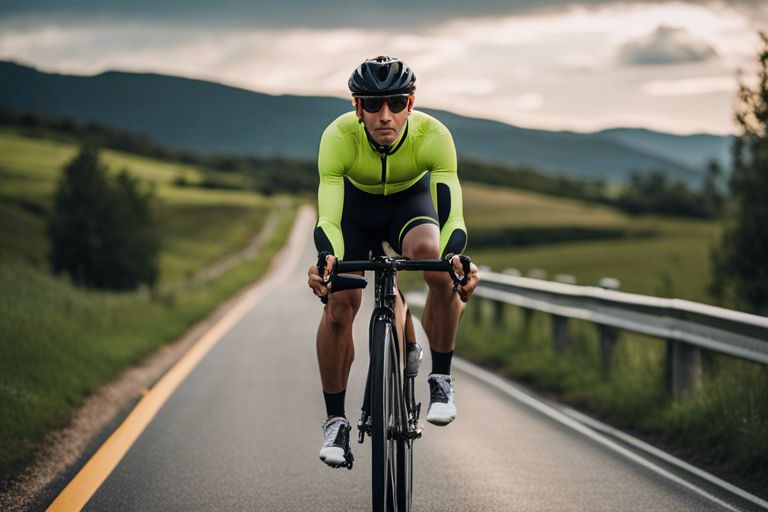In a world where fitness trends come and go, cycling remains a timeless classic. Beyond its nostalgic charm and environmental friendliness, cycling offers a plethora of health and fitness benefits that are hard to match.
Whether you’re a seasoned cyclist or just dusting off your old bike, exploring the world on two wheels can lead to transformative changes in your physical and mental well-being. Join us as we pedal through the myriad benefits of cycling for fitness and health, and discover why this simple activity has captured the hearts of millions around the globe.
Health Benefits of Cycling
Cycling isn’t just a fun way to get around; it’s also a fantastic workout that offers numerous health benefits. Here are some of the key ways cycling can improve your health:
- Cardiovascular Health: Cycling is an excellent aerobic exercise that gets your heart pumping. Regular cycling strengthens your heart muscles, lowers resting pulse, and reduces blood fat levels. This, in turn, improves your overall cardiovascular health and reduces the risk of heart diseases.
- Weight Management and Metabolism: Cycling is a great way to burn calories and lose or maintain weight. It helps boost your metabolism, making your body more efficient at burning calories even when you’re at rest. Cycling can be particularly effective for burning fat, especially when combined with a healthy diet.
- Mental Health and Stress Reduction: Cycling is not only good for your body but also for your mind. It’s a great way to relieve stress and improve your mood. Cycling outdoors exposes you to natural sunlight, which can help alleviate symptoms of depression and anxiety. The rhythmic motion of pedaling can also be meditative and calming.
Incorporating cycling into your routine can have a profound impact on your overall health and well-being. Whether you’re cycling for leisure, commuting, or as part of a fitness regimen, the benefits are undeniable. So, grab your helmet, hit the road, and start reaping the rewards of this enjoyable and beneficial activity.
Fitness Benefits of Cycling
Cycling isn’t just about getting from point A to point B, it’s also an excellent way to improve your overall fitness. Here are some of the key fitness benefits of cycling:
- Muscle Strengthening: Cycling is a fantastic way to strengthen your muscles, especially those in your lower body. The act of pedaling works your calves, thighs, and buttocks, helping to tone and strengthen these muscle groups over time.
- Improves Flexibility and Joint Mobility: Cycling is a low-impact exercise that can help improve flexibility and joint mobility. The repetitive motion of pedaling can help increase the range of motion in your joints, leading to improved flexibility over time.
- Low-Impact Exercise: One of the great things about cycling is that it’s a low-impact exercise, meaning it’s gentle on your joints. This makes it an excellent choice for people of all fitness levels, including those with joint issues or injuries. Plus, cycling can be easily adapted to suit your fitness level, whether you’re a beginner or a seasoned athlete.
Cycling for Weight Loss
Cycling is not only a fun and enjoyable activity but also an effective way to burn calories and aid in weight loss. Here’s how cycling can help you shed those extra pounds:
- Burns Calories: Cycling is a great way to burn calories, especially when done at a moderate to high intensity. The number of calories burned during a cycling workout depends on factors like your weight, cycling speed, and terrain. On average, a person weighing around 155 pounds can burn about 260 calories in 30 minutes of moderate cycling.
- Boosts Metabolism: Regular cycling can help boost your metabolism, making your body more efficient at burning calories even when you’re at rest. This can aid in weight loss by helping you burn more calories throughout the day.
- Tips for Incorporating Cycling into a Weight Loss Regimen:
- Set Realistic Goals: Set achievable weight loss goals and track your progress to stay motivated.
- Start Slow: If you’re new to cycling, start with short rides at a comfortable pace and gradually increase the duration and intensity as you build stamina.
- Mix It Up: Include a variety of cycling workouts in your regimen, such as interval training, hill climbs, and leisurely rides, to keep things interesting and challenge your body.
- Combine with a Healthy Diet: While cycling can help you burn calories, it’s important to combine it with a healthy, balanced diet for optimal weight loss results.
- Stay Consistent: Consistency is key when it comes to weight loss. Aim to incorporate cycling into your routine regularly to see the best results.
Cycling for Mental Health
Cycling isn’t just beneficial for your physical health, it can also have a positive impact on your mental well-being. Here’s how cycling can benefit your mental health:
- Reduced Anxiety and Depression: Cycling, like other forms of aerobic exercise, can help reduce symptoms of anxiety and depression. Exercise, including cycling, releases endorphins, which are chemicals in the brain that act as natural mood lifters. Regular cycling can also help reduce levels of stress hormones in the body, leading to a calmer mind and reduced feelings of anxiety and depression.
- Improved Mood: Cycling outdoors can have a profound impact on your mood. Spending time in nature and soaking up the sunlight can help boost your mood and improve your overall sense of well-being. The combination of physical activity and being outdoors can leave you feeling rejuvenated and more positive.
- Stress Reduction: Cycling can be a great way to relieve stress. The rhythmic motion of pedaling, combined with the fresh air and scenery, can help clear your mind and reduce feelings of stress and tension. Cycling can also serve as a form of meditation, allowing you to focus on the present moment and let go of worries and distractions.
Cycling Safety Tips
Cycling is a fun and enjoyable activity, but it’s important to prioritize safety when you’re out on the road. Here are some essential cycling safety tips to keep in mind:
- Wear a Helmet: Always wear a properly fitting helmet when cycling. A helmet can significantly reduce the risk of head injuries in the event of a fall or collision.
- Use Proper Gear: Wear appropriate clothing and footwear for cycling. Bright and reflective clothing can help make you more visible to other road users, especially in low-light conditions.
- Check Your Bike: Before heading out, check that your bike is in good working condition. Ensure the brakes, tires, and gears are functioning properly.
- Follow Traffic Rules: Obey all traffic laws and signals. Ride in the same direction as traffic, and use hand signals to indicate turns.
- Stay Visible: Make yourself visible to other road users by using lights and reflectors, especially when cycling in low-light conditions or at night.
- Be Aware of Your Surroundings: Stay alert and aware of your surroundings at all times. Look out for obstacles, pedestrians, and other road users.
- Avoid Distractions: Do not use headphones or mobile phones while cycling, as they can distract you from your surroundings.
- Be Predictable: Ride in a predictable manner, and signal your intentions clearly to other road users.
- Cycling in Traffic: When cycling in traffic, stay in a visible position on the road and avoid riding in the blind spots of vehicles. Make eye contact with drivers to ensure they see you.
- Use Bike Lanes and Paths: Whenever possible, use designated bike lanes and paths to separate yourself from vehicular traffic.
Cycling Equipment and Gear
Whether you’re a seasoned cyclist or just starting, having the right gear is essential for a safe and enjoyable riding experience. Here are some essential cycling gear and equipment you should consider:
- Helmet: A properly fitting helmet is crucial for protecting your head in the event of a fall or collision. Look for helmets that meet safety standards and provide adequate ventilation.
- Bike Lights: Front and rear bike lights are essential for visibility, especially when riding in low-light conditions or at night. Choose lights that are bright, durable, and easy to attach to your bike.
- Reflective Clothing: Wearing reflective clothing can help make you more visible to other road users, especially in low-light conditions. Consider wearing a reflective vest, jacket, or ankle bands.
- Bike Lock: A sturdy bike lock is essential for securing your bike when you’re not around. Look for locks that are durable and difficult to cut or break.
- Water Bottle and Cage: Staying hydrated is important when cycling. Consider investing in a water bottle and cage to keep water easily accessible during your rides.
- Bike Pump: A portable bike pump is essential for maintaining proper tire pressure. Look for a pump that is compact and easy to carry with you on rides.
- Spare Tubes and Patch Kit: It’s a good idea to carry spare inner tubes and a patch kit in case you get a flat tire. Make sure you know how to change a flat tire before heading out on a ride.
- Proper Bike Maintenance: Regular bike maintenance is crucial for safety and performance. Make sure to keep your bike clean, lubricate the chain, and check for any signs of wear and tear on a regular basis.
How to Get Started with Cycling?
Cycling is a fantastic way to stay fit, explore your surroundings, and enjoy the outdoors. If you’re new to cycling, here’s a step-by-step guide to help you get started:
- Choose the Right Bike:
- Consider the type of cycling you’ll be doing (road cycling, mountain biking, commuting, etc.) and choose a bike that’s suitable for that purpose.
- Visit a local bike shop to get expert advice on choosing the right size and type of bike for your needs and budget.
- Get the Essential Gear:
- Purchase a helmet that fits properly and meets safety standards.
- Invest in comfortable cycling clothing, including padded shorts and moisture-wicking shirts.
- Consider purchasing bike lights, a water bottle and cage, a bike pump, and a basic repair kit.
- Learn the Basics:
- Familiarize yourself with the different parts of your bike and how they work.
- Practice basic skills such as mounting and dismounting, shifting gears, and braking safely.
- Start Slow:
- Begin with short rides at a comfortable pace to build your fitness and confidence.
- Gradually increase the duration and intensity of your rides as you become more comfortable on your bike.
- Find Cycling Routes:
- Look for local cycling routes and paths that are suitable for beginners.
- Use online mapping tools or cycling apps to plan your routes and track your progress.
- Join a Cycling Group or Club:
- Consider joining a local cycling group or club to meet other cyclists and learn from more experienced riders.
- Group rides can be a great way to explore new routes and improve your cycling skills.
- Practice Safety:
- Always wear your helmet and other safety gear when cycling.
- Obey traffic laws and signals, and ride defensively to stay safe on the road.
- Enjoy the Ride:
- Cycling is not just about exercise, it’s also about enjoying the journey. Take time to appreciate the scenery and the feeling of freedom that cycling brings.
Conclusion
Cycling offers a multitude of benefits for both fitness and health, making it a fantastic activity for people of all ages and fitness levels. From improving cardiovascular health and muscle strength to reducing stress and anxiety, cycling can have a transformative impact on your overall well-being. By incorporating cycling into your routine, you can enjoy improved fitness, better mental health, and a greater sense of well-being.
So, whether you’re looking to lose weight, improve your fitness, or simply enjoy the outdoors, cycling is a great choice. Grab your bike, hit the road, and start reaping the rewards of this enjoyable exercise. Your body and mind will thank you for it!




